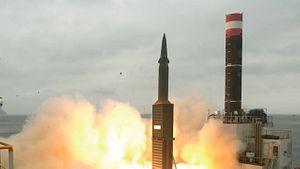South Korea carried out the initial test fires of a new, heavy payload ballistic missile in March 2020, Yonhap News Agency, citing an official source, reported this week. The missile, known as the Hyunmoo-4, saw two tests from the Anheung Proving Grounds on the country’s west coast.
Little has been published officially on the Hyunmoo-4, but like the Hyunmoo-II and its variants, the system is thought to be a solid-propellant rocket. The Hyunmoo-4, however, has been reported to carry a payload as large as 2 tons to ranges of up to 800 kilometers. Testing was overseen by the Agency for Defense Development, South Korea’s indigenous defense research and development organization. According to Yonhap, two Hyunmoo-4 projectiles were tested in March, but one “misfired.”
The 2 ton payload for the Hyunmoo-4 was made possible by revisions to the U.S.-South Korea missile guidelines, which previously governed payload limits. Although range limits remain, the development of a missile like the heavy-payload Hyunmoo-4 could enable South Korea to in the future use the same booster with a reduced payload to significantly extend the missile’s range to that of a medium-range ballistic missile. No pictures have been released of the March Hyunmoo-4 test and it remains unclear what booster is being used for the missile. With the larger suspected payload weight and similar range goal as the Hyunmoo-2C, the Hyunmoo-4 would need an all-new, larger booster design.
Hyunmoo-4 will likely play an important role in the Korea Massive Punishment and Retaliation (KMPR) plan, which is designed to allow the South Korean armed forces rapid options to decapitate the North Korean leadership. The larger payload of the Hyunmoo-4 may allow for the accommodation of an earth-penetrating conventional warhead, which could hold North Korean leadership targets at risk at several underground facilities around the country. North Korea has scores of military underground facilities scattered across its mountainous terrain.
In 2017, South Korea first began testing the 800 kilometer range Hyunmoo-2C ballistic missile, which would allow it to strike any part of North Korea from within its borders. The missile guideline revisions came amid an unprecedented year of North Korean ballistic missile testing that year, which included the first tests of North Korea’s intercontinental-range ballistic missiles.
Since the testing of the Hyunmoo-2C, North Korea has introduced a new suite of short-range ballistic missiles with quasi-ballistic flight qualities and reportedly increased precision. One of these missiles, known to U.S. intelligence agencies as the KN23, resembles Russia’s Iskander-M short-range ballistic missile and South Korea’s Hyunmoo-2C.

































